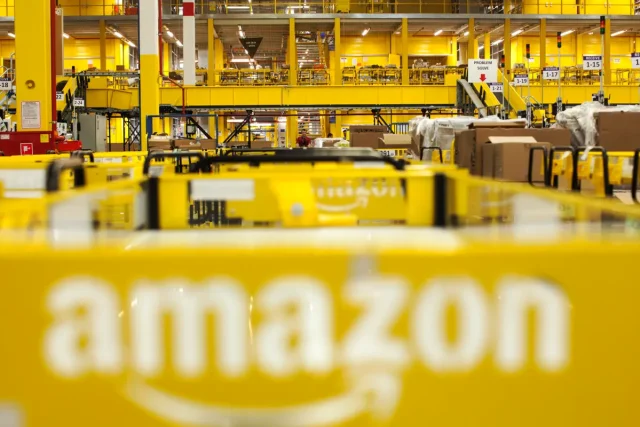
Amazon, the global e-commerce behemoth, has revolutionized the way we shop online. From its humble beginnings as an online bookstore in 1994, it has rapidly evolved into a retail giant offering a vast array of products and services. One of the key pillars of Amazon’s success is its impeccable supply chain management. In this article, we will delve deep into how Amazon has perfected its supply chain management to become a global e-commerce giant.
1. Customer-Centric Approach
Amazon’s journey to supply chain excellence starts with its unwavering commitment to its customers. Founder and CEO, Jeff Bezos, has repeatedly emphasized the importance of customer satisfaction. This customer-centric approach extends to the heart of its supply chain management. Amazon strives to fulfill customer orders as quickly and accurately as possible, and this ethos drives many of its supply chain decisions.
2. Fulfillment Centers and Warehousing
Amazon’s extensive network of fulfillment centers is at the core of its supply chain. These strategically located centers ensure that products are stored close to the end consumer, reducing delivery times and costs. Amazon continually invests in automation and robotics within these centers to improve efficiency. The Kiva robots, for example, can autonomously move shelves of products to workers, reducing the time it takes to pick and pack orders.
3. Data-Driven Decision Making
Data is Amazon’s secret weapon. The company collects vast amounts of data on customer behavior, inventory levels, and transportation logistics. This data is then used to optimize various aspects of its supply chain. For instance, Amazon’s predictive analytics can anticipate which products will be in high demand in specific regions, allowing for proactive stocking.
4. Prime and Fulfillment by Amazon (FBA)
Amazon Prime, the company’s subscription service, is a game-changer in supply chain management. It offers members expedited shipping, among other benefits, incentivizing customers to make more purchases. Additionally, Fulfillment by Amazon (FBA) allows third-party sellers to store their products in Amazon’s fulfillment centers, taking advantage of Amazon’s logistics expertise.
5. Advanced Transportation Network
Amazon operates an extensive transportation network, including trucks, planes, and even its own delivery drones. This integrated approach enables Amazon to exert greater control over its delivery times and costs. The Amazon Air fleet, for example, can transport goods across the globe quickly, reducing reliance on third-party carriers.
6. Inventory Management
Amazon’s inventory management is a fine-tuned art. The company employs algorithms that predict demand for products with impressive accuracy. This leads to reduced overstocking and understocking issues, optimizing storage space and reducing carrying costs.
7. Vendor Management and Relationships
Amazon values its relationships with suppliers and vendors. The company uses data and performance metrics to collaborate with vendors, ensuring that the supply chain runs smoothly. It encourages suppliers to adopt advanced technologies and practices to enhance efficiency.
8. Case Study: Amazon Prime Day
Amazon Prime Day, an annual sales event, exemplifies the power of Amazon’s supply chain. In 2021, the event generated over $11 billion in sales. The successful execution of Prime Day relies heavily on Amazon’s ability to manage a surge in orders, coordinate logistics, and deliver products promptly to millions of customers.
9. Sustainability Initiatives
Amazon is committed to sustainability in its supply chain. In 2019, the company pledged to become carbon neutral by 2040. It aims to have 100,000 electric delivery vehicles on the road by 2030 and invests in renewable energy projects. These initiatives not only reduce its environmental footprint but also generate positive public relations.
10. Challenges and Future Prospects
Amazon’s supply chain management is not without challenges, including labor disputes, regulatory scrutiny, and the complexity of global operations. However, the company’s relentless focus on innovation and efficiency positions it to continue dominating the e-commerce landscape in the years to come.
Amazon’s supply chain management is a masterclass in e-commerce success. Its customer-centric approach, data-driven decision-making, extensive fulfillment network, and commitment to sustainability have allowed it to consistently deliver a seamless shopping experience to millions of customers worldwide. As Amazon continues to innovate and adapt, its supply chain management will remain a cornerstone of its global dominance in e-commerce.
Here are some links for our readers with valuable perspectives from reputable sources that support and expand on the ideas discussed in this article. Explore and enrich yourself.
- Harvard Business Review – “How Amazon’s Bottomless Appetite Became Corporate America’s Nightmare”
This article provides insights into Amazon’s supply chain strategies and their impact on the business landscape. It offers a comprehensive view of Amazon’s dominance and challenges in the e-commerce sector. Read more - Forbes – “How Amazon Is Revolutionizing Supply Chain Management”
Forbes explores how Amazon has transformed supply chain management with cutting-edge technology and data-driven decisions. It discusses Amazon’s innovations in logistics and fulfillment. Read more - MIT Sloan Management Review – “What Makes Amazon the King of Supply Chain Efficiency?”
This academic source delves into the specific supply chain strategies that have made Amazon a leader in efficiency. It discusses concepts like predictive analytics and demand forecasting. Read more - Supply Chain Dive – “Amazon’s Supply Chain and Logistics Costs Grow as Sales Boom”
This article provides data-driven insights into Amazon’s supply chain costs and how they’ve evolved as the company has grown. It discusses the challenges Amazon faces in managing its logistics. Read more - The Wall Street Journal – “Amazon Faces Widening Crackdown by European Union Over Data Use”
This source discusses regulatory challenges that Amazon has encountered, including data-related issues. It provides a perspective on how regulations can impact e-commerce giants. Read more
Read more write-ups of this author: Click Here

About The Author:
Mirza Rakib Hasan Shovon
Managing Director and CEO
Aristo Tex International
Technet Corporation
ANYVAS
Director
Research & Development
International Corporate Association of Professionals (InCAP)














